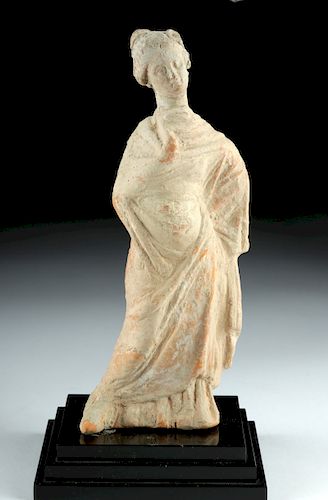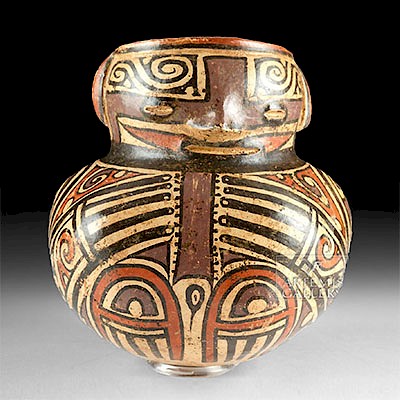Graceful Greek Tanagra Pottery Female Votive Figure
Lot 14a
About Seller
Artemis Fine Arts
686 S Taylor Ave, Ste 106
Louisville, CO 80027
United States
Selling antiquities, ancient and ethnographic art online since 1993, Artemis Gallery specializes in Classical Antiquities (Egyptian, Greek, Roman, Near Eastern), Asian, Pre-Columbian, African / Tribal / Oceanographic art. Our extensive inventory includes pottery, stone, metal, wood, glass and textil...Read more
Estimate:
$1,700 - $2,550
Absentee vs Live bid
Two ways to bid:
- Leave a max absentee bid and the platform will bid on your behalf up to your maximum bid during the live auction.
- Bid live during the auction and your bids will be submitted real-time to the auctioneer.
Bid Increments
| Price | Bid Increment |
|---|---|
| $0 | $25 |
| $300 | $50 |
| $1,000 | $100 |
| $2,000 | $250 |
| $5,000 | $500 |
| $10,000 | $1,000 |
| $20,000 | $2,500 |
| $50,000 | $5,000 |
| $100,000 | $10,000 |
| $200,000 | $20,000 |
About Auction
By Artemis Fine Arts
Nov 8, 2018
Set Reminder
2018-11-08 10:00:00
2018-11-08 10:00:00
America/New_York
Bidsquare
Bidsquare : Ancient / Ethnographic From Around The World
https://www.bidsquare.com/auctions/artemis-gallery/ancient-ethnographic-from-around-the-world-3598
Ancient art from Egypt, Greece, Italy and the Near East, as well as Asian, Pre-Columbian, Native American, African / Tribal / Oceanic, Spanish Colonial, Russian Icons, Fine art, much more! Artemis Fine Arts info@artemisgallery.com
Ancient art from Egypt, Greece, Italy and the Near East, as well as Asian, Pre-Columbian, Native American, African / Tribal / Oceanic, Spanish Colonial, Russian Icons, Fine art, much more! Artemis Fine Arts info@artemisgallery.com
- Lot Description
Central Greece, Boeotia, ca. 4th to 3rd century BCE. An expertly rendered, hollow-cast female figure with a delicately modeled face, wavy locks pulled back from her face to a high bun, and presenting a standing yet dynamic dance-like pose with bent limbs and her head cocked to one side. Her body is elegantly draped in a voluminous himation over her chiton. A beautiful example with nice remains of original white slip. Similar examples may be found in Reynold Higgins' "Tanagra and the Figurines" (Princeton University Press, 1987). Figures like this example would have been taken to temples and placed as votive offerings. Size: 7.25" H (18.4 cm); 8.125" H (20.6 cm) on included custom stand.
Tanagras are named after the site in Boeotia, central Greece, where thousands of similar figures were unearthed in the early 1870s. Figures of men, children, and comic actors were also found at Tanagra, but standing female figures are the most numerous. The chief appeal of Tanagra figures lies in their exceptional artistic quality usually considered to be the finest of all Greek figurines. The ladies are normally depicted in casual poses and their clothes, which usually consist of a thinner undergarment, the chiton, worn beneath a thicker cloak or himation, are typically pulled and twisted in pleasing patterns which emphasize the form of the figure beneath. Most Tanagra figures are mold made and sometimes have a vent cut in the back to ensure even distribution of heat in the firing. After firing, the figure was coated in a white slip, often a solution of chalk or white clay, and then colors were added on top. The artists who produced these figures were known as coroplasts, literally 'modelers of girls.'
Provenance: private East Coast, USA collection
All items legal to buy/sell under U.S. Statute covering cultural patrimony Code 2600, CHAPTER 14, and are guaranteed to be as described or your money back.
A Certificate of Authenticity will accompany all winning bids.
We ship worldwide and handle all shipping in-house for your convenience.
#137831Head has been reattached; some archaeological encrustation to body with some original pigment remaining.Condition
- Shipping Info
-
All shipping is handled in-house for your convenience. Your invoice from Artemis Gallery will include shipping calculation instructions. If in doubt, please inquire BEFORE bidding for estimated shipping costs for individual items.
-
- Buyer's Premium



 EUR
EUR CAD
CAD AUD
AUD GBP
GBP MXN
MXN HKD
HKD CNY
CNY MYR
MYR SEK
SEK SGD
SGD CHF
CHF THB
THB














